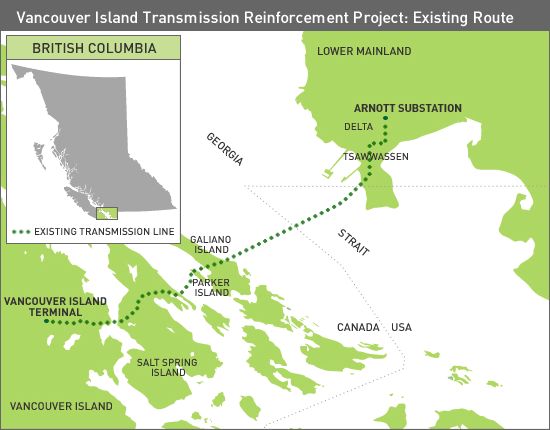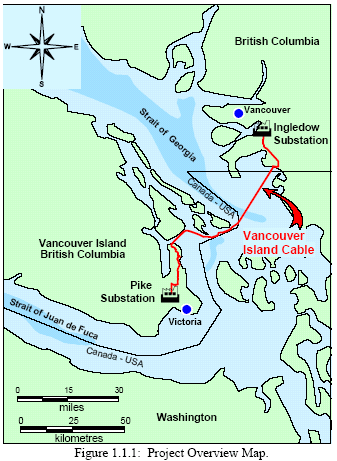

Crossed wires at the BCUC -
VITR and VIC as of October 5, 2005
Vancouver Island Transmission Reinforcement (VITR)
Background
The Vancouver Island Transmission Reinforcement (VITR) is a project of the BC Transmission Corporation (BCTC) to build a 230 kV AC transmission cable to carry electricity from the Lower Mainland to Vancouver Island. BCTC filed an application for a Certificate of Public Convenience and Necessity (CPCN) for the VITR with the BC Utilities Commission (BCUC) in July 2005. The project is stated to cost about $245 million and will be completed in two phases, operational in October 2008 and Phase II when required, 2017 is suggested.
BCTC-VITR site: http://tinyurl.com/e4j9e
BCUC project site: http://www.bcuc.com/ApplicationView.aspx?ApplicationId=78
EAO project site: http://www.eao.gov.bc.ca/epic/output/html/deploy/epic_project_home_250.html
The proposed route would be overland on existing right-of-way (ROW) from Arnott Terminal in South Delta, through Tsawwassen; underwater to Galiano Island (through the United States, for half of this first underwater leg); overland at Galiano; underwater again to Salt Spring Island; then overland on existing ROW on Salt Spring, across Sansum Narrows, and to Vancouver Island Terminal just north of Duncan in North Cowichan. (map, below)
It is referred to by the BCUC as BCTC-VITR.
BCTC-VITR is at the pre-application stage of an environmental assessment (EA) by the BC Environmental Assessment Office (EAO).
The application to BCUC contains this paragraph, surrendering considerable discretion to the BCUC with respect to changes to the proposed transmission solution, but pleading for approval:
BCTC must have a transmission solution to Vancouver Island in place by the fall of 2008. ... BCTC respectfully requests that the Commission approve the Project as proposed, or with modifications considered to be in the public convenience and necessity and supported by the evidence, rather than denying the Project if it finds that the Project, as proposed, is not in the public interest. [1.4 Order Sought]
BCTC-VITR Timetable: Hearing November 28, 2005
Here are the key dates in the BCUC timetable for the BCTC-VITR proceeding, revised as of October 5, 2005:
16 Sep 2005 Intervenor and Interested Party Registration
16 Sep 2005 Participant Assistance/Cost Award Budgets
10 Oct 2005 BCTC Responses to Information Requests
17 Oct 2005 Intervenor Evidence
12 Oct 2005 Sea Breeze to file further motions for the Pre-hearing Conference
21 Oct 2005 Pre-hearing Conference
26 Oct 2005 BCUC and Participant Information Requests to Intervenors
10 Nov 2005 Intervenor Responses to Information Requests
12 Nov 2005 Town Hall Meeting (Salt Spring)
16 Nov 2005 Staff issue Hearing Issues List
19 Nov 2005 Town Hall Meeting (Vancouver Island)
21 Nov 2005 Town Hall Meeting (Tsawwassen)
21 Nov 2005 Open Oral Submissions
22 Nov 2005 BCTC Consolidation of Hearing Issues List
24 Nov 2005 Panel issues Hearing Issues List
28 Nov 2005 Public Hearing Commences
Intervenors
There are now 50 intervenors in the BCUC-VITR proceeding. Compare this to the Duke Point - Electricity Purchase Agreement hearing, which had 39 intervenors, or the Terasen - Kinder Morgan Acquisition hearing, with 31.
Many of these intervenors are residents along the ROW in Tsawwassen and on Salt Spring.
Two organizations, TRAHVOL and IRAHVOL (Tsawwassen/Island Residents Against High Voltage Overhead Lines) have filed as intervenors to represent the concerns of these respective residents. More, below
The Corporation of Delta, the Islands Trust, Capital Regional District - these local governments have registered, also representing local interests.
South Delta Secondary School & Delta School District, again, representing local concerns.
The Elk Valley Coal Corporation, Norske Canada, Joint Industry Electricity Steering Committee (JIESC), Terasen
Sea Breeze Pacific Regional Transmission System Inc. - see more, below
GSX Concerned Citizens Coalition.
No Vanport Sterilizers, yet.
Interest of IRAHVOL and TRAHVOL and others
IRAHVOL and TRAHVOL share concerns about electromagnetic fields (EMF) generated by alternating current transmission systems, and about continued use of overhead transmission lines. TRAHVOL is opposed to the VITR route through the Tsawwassen ROW, irrespective of whether it goes overhead or underground. IRAHVOL is likewise opposed to continued use of the Salt Spring ROW, and is pushing for an all-submarine cable.
Both organizations have engaged lawyers to represent them at the BCUC. TRAHVOL have engaged Mark Underhill and Joe Arvay. Arvay is one of the lawyers that dominates public interest legal issues in British Columbia. His firm also does work for the provincial government. (Chris Jones, at the time working for Arvay Finlay, represented the province in support of the GSX Pipeline.) Murray Rankin is also advising.
IRAHVOL have engaged David Austin, a director of and legal agent for the Independent Power Producers of BC. Austin has a long history of critical opinion on energy issues in BC, and particularly with respect to BC Hydro.
While we're still on lawyers, Delta is represented by James Yardley, who represented Abbotsford and later, David Suzuki Foundation, in the Sumas Energy 2 Powerline proceeding.
Delta essentially supports the TRAHVOL position and is opposed to the current BCTC to underground in existing ROW in Tsawwassen and supports alternative technologies or routes that eliminate concerns with EMF.
www.irahvol.org
www.trahvol.org
Vancouver Island Cable (VIC)
Interest of Sea Breeze Pacific Regional Transmission System Inc.
Sea Breeze is proposing an alternative to the BCTC-VITR, and on September 30, 2005, filed an application for a CPCN with the BCUC for the Vancouver Island Cable (VIC) project, a 550 MW HVDC Light cable system. HVDC Light is proprietary technology of ABB, and purports to have performance benefits that are superior to those of AC transmission.
The VIC application to BCUC gives a cost comparison table that shows Phase I & II of the VITR project at $266 million and the VIC project at $324 million. Sea Breeze then factors in other costs and benefits associated with VITR and VIC and gives a "Total Project Cost" for VITR of $289 million and VIC of $163 million. There's a great amount of apples-to-oranges in this table, and the ensuing complex discussion that is about to unfold between the two projects won't be easy stuff.
Sea Breeze Vancouver Island Cable site: www.vancouverislandcable.com
The VIC proposed route is underground or underwater along its entire length. From the Ingledow Substation in Surrey to White Rock it proposes to run alongside existing roads. It would run underwater from White Rock, through the United States to the southeast end of Saturna Island, then along the GSX Pipeline route to the north end of the Saanich Peninsula. On land again, it would run alongside roads or other powerline ROW to Pike Substation. (map, below)
Some argue that BCTC appears to be biased against DC transmission. Phasing out its existing HVDC. Denying that ABB's DC Light technology has merit. In April, BCTC released a report it had commissioned which concluded that "For VITR, HVDC LightTM is more expensive to construct, has higher losses, and costs more to maintain than the 230 kV ac alternative. It does not offer any technical advantage in this situation ...."
http://www.sqwalk.com/Rashwan_HVDCLightAnalysis_2005-04-08.pdf
Hearing Process
In its application, Sea Breeze says it filed the VIC CPCN application as a result of an invitation by the Commission on August 9.
The "invitation" is included in the hearing order for BCTC-VITR, and says this:
If Sea Breeze files a CPCN Application and desires to have it reviewed in this proceeding, then Sea Breeze should file the CPCN Application ...no later than the end of September 2005. Participants should assume that information requests to Sea Breeze will be due on October 17, 2005, assuming Sea Breeze files either a CPCN Application or Intervenor Evidence. http://tinyurl.com/be8lo
Sea Breeze then recommends that the BCUC confirm its consolidation of the VIC CPCN application with the existing BCTC-VITR proceeding.
This should be challenging - for the Commission, for intervenors, and for the public interest. Stay tuned.
What's this?
The bottom of a number of pages of the BCTC-VITR application filed with BCUC contains this peculiar image:
![]()
http://tinyurl.com/bh774
Perhaps the company slogan should be "designed in mirrors".

